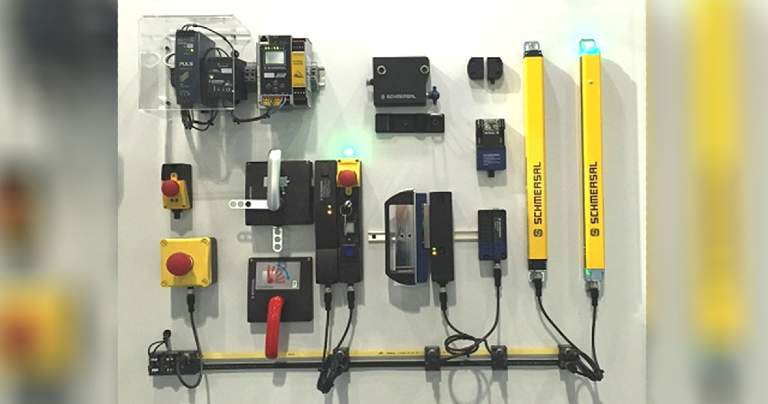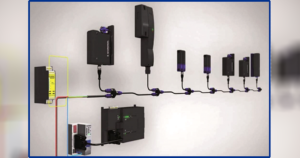Efficiency in Machine Safety
By EPR Magazine Editorial September 25, 2021 3:37 pm IST
By EPR Magazine Editorial September 25, 2021 3:37 pm IST

The primary goal while designing a machine has always been to make its automation process as efficient and cost-effective as possible to complete a task. Now safety controls, with their more stringent requirements, are being held to similar expectations when being integrated into the machine controls. Safety control devices have evolved over the years and now play a crucial role in the interaction of man and machine.
What was once an afterthought, safety aspects can be seen as being implemented during the design phase by machine builders, and added to older existing machines by the end-users. The challenge with implementing safety at any stage of a machine lifecycle is making sure the safety system is effective and efficient as possible.
The automation process behind the scenes of a mid to large size machine can be intricate while providing simple means to operate the machine via a Human Machine Interface (HMI). This allows a complex automation process to be seamless and user friendly. Safety too can be seamless and user friendly. The first approach would be to minimise hazards by design. If feasible for the machine and its application this may reduce the cost on safety as the required safety components may be less.
If, as in many situations, a hazard cannot be reduced or eliminated purely by design, or if further action is required, then safety devices can be integrated. These could include guard monitoring devices that will prevent a machine cycle while a guard is open, or presence sensing devices such as light curtains or safety mats that will detect an operator.
 Once a risk analysis is completed to determine what hazards need to be guarded and to which degree of circuit reliability, the question then turns to how to integrate the safety efficiently? As stated earlier, the automation design may be complex throughout the machine with many components requiring communication with each other to assure the process run smoothly. In many instances this communication takes place in the form of a network protocol that allows data packages to be exchanged throughout the system and can even be visually displayed on a control panel. Safety devices have evolved where they too can be placed on such a network. Knowing immediate information such as which guard door is open, which E-STOP has been actuated, and which safety device has faulted out can drastically decrease downtime and thus increase productivity. An added advantage to most electronic safety devices is that they can be wired in series without reducing the integrity of the safety circuit.
Once a risk analysis is completed to determine what hazards need to be guarded and to which degree of circuit reliability, the question then turns to how to integrate the safety efficiently? As stated earlier, the automation design may be complex throughout the machine with many components requiring communication with each other to assure the process run smoothly. In many instances this communication takes place in the form of a network protocol that allows data packages to be exchanged throughout the system and can even be visually displayed on a control panel. Safety devices have evolved where they too can be placed on such a network. Knowing immediate information such as which guard door is open, which E-STOP has been actuated, and which safety device has faulted out can drastically decrease downtime and thus increase productivity. An added advantage to most electronic safety devices is that they can be wired in series without reducing the integrity of the safety circuit.
Many manufactures of safety devices have the ability to allow their devices to communicate on dedicated protocols such as PROFINET, EtherNet, CANopen and DeviceNet, just to name a few. In some instances a manufacturer may require a gateway that will convert their proprietary form of communication to one of the common industrial protocols, allowing a uniform data stream of safe and non-safe information.
Another available protocol to use is the Actuator Sensor Interface, or AS-i protocol. One of AS-i key features is that this protocol is an open language allowing machine builders and end users to easily mix and match different manufacturers AS-I devices and components to meet their various application needs. Another advantage of an AS-I system is its easy wiring which only requires a 4 pin snap-on along any point of its flat cable, greatly reducing the costs in installation time.
With these types of technology, safety components no longer need to be completely isolated from the automation system. As an interlock device triggers a safe shutdown it can send information through a PLC to bring a machine tool to a home position, all while showing its activity in a graphical representation on an easy-to-read screen at an operator station.
The increased efficiency in trouble-shooting can easily be seen when this technology is compared with that of conventional electromechanical devices on mid to large-sized machines. When using electromechanical devices, each access guard needs to be examined individually to determine which is preventing a machine restart. Use of some of the advanced electronic safety devices can quickly and easily inform the operator of a specific fault through integrated LED lights and serial diagnostic signals.
Properly designed and installed safety systems within a machine are no longer seen as a hindrance to the overall process. Education in safety provides a greater understanding and appreciation for its use and technological advancements makes safety implementation easier. The current capabilities of safety devices allow them to be used both effectively and efficiently.
Author:
Devin MurrayFunctional Safety Engineer
TÜV Rheinland ID-No. 4274/11 Machinery
Schmersal USA
Image credits:
K.A. Schmersal GmbH & Co. KG
© 2015
SCHMERSAL INDIA PVT LTD
Plot No – G-7/1, Ranjangaon MIDC,
Tal. – Shirur, Dist. – Pune 412 220.
+91-9607800255 | SWankhede@schmersal.com
We use cookies to personalize your experience. By continuing to visit this website you agree to our Terms & Conditions, Privacy Policy and Cookie Policy.